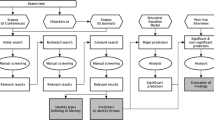A human being can only survive in the Age of Machinery if the ethical norms of life are held sacred. This Shamanist protest at the destructive power of evil, as expressed in theCurse Upon Iron, stands forth prominently in a society in moral crisis.
Abstract
Health and safety at work is a moral imperative, but the debates emphasise only the economic and legal sides. Drawing on case material from working with VDUs and other forms of modern technology it is shown that loss of control over their immediate work processes can be stressful and potentially harmful to responsible operators. Autonomy and freedom in work process control enhances the power that workers have to protect their health. It is suggested that unquestioned divisive and dualistic practices at workplaces are a potent and unnecessary reason for this problem.
Similar content being viewed by others
References
Accident Investigation Board Aircraft Report 9/82.On the Collision in the Zagreb Area Yugoslavia, between British Airways Trident G-AWZT and Index Adria DC-9 Yu-AJR on 10 September 1976, H.M.S.O. London.
Air Safety Review. (1983).Air Safety Review (No. 7). July. British Airways. London.
Babb, P. and P. Shipley. (1994). A Study of Stress in Telephone Switchboard Operation. Paper submitted toApplied Ergonomics.
Branton, P. and P. Shipley. (1986). VDU Stress: is Houston Man Addicted bored or mystic? In Knave, B. and P. Widebæck. (eds.)Proceedings of International Scientific Conference on Work with Display Units. Stockholm. Sweden.
Camden & Islington Occupational Health Project. (1994).Occupational Health News. 3. Autumn. C&IOHP. London.
Carter, J. B., and E.W. Banister. (1994). Muskulo-skeletal Problems in VDT Work: a Review.Ergonomics. 37 (10). 1623–1648.
Clark, H. (1993).The Cure For all Cancers. Promotion Publishing. San Diego, California.
Dalton, A.J.P. (1992). Lessons from the United Kingdom: fightback on workplace hazards, 1979–1992.International Journal of Health Services. 22 (3) 489–495.
Dalton, A.J.P. (1993). It's My Job, Doc!Occupational Health Review. Jan/Feb.
Damodaran, L., A.S. Simpson and P.A. Wilson (1980).Designing Systems for People. National Computing Centre. Manchester, U.K.
Department of Health (1993)Workplace Transfer Report. Department of Health (DoH), London.
Fisher, S. (1985). Control and blue-collar Work. In Cooper, C.L. and M.J. Smith (eds.)Job Stress and Blue Collar Work. Wiley Chichester, UK.
Gaillard, A.W.K. and C.J.E. Wientjes. (1994). Mental Load and Two Types of Energy Mobilization. Works and Stress. Special issue:A Healthier Work Environment. 8(2). 141–152.
Garson, B. (1988).The Electronic Sweatshop: how computers are transforming the office of the future into the factory of the past. Simon & Schuster. New York.
Griffiths, A. (1994) The Management of Muskulo-skeletal Upper Limb Disorders and White-collar Work in the UK.Work & Stress 8 (1). 1–3.
Grosdera, T. and M. de Montmollin. (1994).Reasoning and Knowledge of Nuclear Power Plant Operators in Case of Accidents. Applied Ergonomics. 25 (5). 305–308.
Health & Safety Executive. (1992).Display Screen Equipment at work: guidance on regulations. H.M.S.O London.
Hodgson, J.T., J.R. Jones, R.C. Elliot and J. Osman. (1993).Self-reported Work-related Illness. Health & Safety Executive, Research Paper 33. H.M.S.O. London.
Howard, G.S. (1992). No Middle Voice.Theoretical and Philosophical Psychology. 12. 12–26.
Huws, U. (1994).Home Truths. National Group on Homeworking Report. London.
Kopec, D. and D. Michie. (1983).Mismatch Between Machine Representations and Human Concepts: Dangers and Remedies. FAST Series No. 9, Science and Technology Policy. Commission of the European Communities. Brussels.
Leal, F. and P. Shipley. (1992). Deep Dualism.International Journal of Applied Philosophy. 7 (2). 33–44.
Levi, L. (1994). Work, Worker and Wellbeing: an overview.Work and Stress. Special Issue: A Healthier Work Environment. 8 (2). 79–83.
London Hazards Centre Trust. (1993).VDU Work and the Hazards to Health. L.H.C. London.
Macmurray, J. (1961).Persons in Relation. Reprinted by Humanities Press 1991. New Jersey, USA.
Marsella, A.J. (1994). The Measurement of Emotional Reactions to Work: conceptual, methodological and research issues.Work and Stress. Special issue:A Healthier Work Environment. 8 (2) 153–176.
Moore-Ede, M. (1993).The 24-hour Society: the risks, costs and challenges of a world that never stops. Piatkus. London.
Oborne, D.J., R. Branton, F. Leal, P. Shipley and T. Stewart. (eds.) (1993).Person-centred Ergonomics: A Brantonian view of human factors. Taylor & Francis, London.
Orlans, V. and P. Shipley. (1993)A Survey of Stress Management and Prevention Facilities in a Sample of UK Organisations. A Report for the Stress Research and Control Centre, Birkbeck College, university of London.
Provenzo, E. (1991).Video Kids: making sense of Nintendo. Harvard University Press. Harvard. USA.
Rosenbaum, M. (1993). The Three Functions of Self-control Behaviour: redressive, reformative and experiential.Work & Stress. 7 (1). 33–46.
Shipley, P. (1993).An Evaluation of the Camden Occupational Health Project. A Report for the King's Fund Institute. London.
Siegrist, J. and R. Peter. (1994). Job Stressors and Coping characteristics in Work-related Disease: issues of validity.Work and Stress. Special issue:A Healthier Work Environment. 8 (2). 130–140.
Special issue ofWork and Stress. (1993). Coping with Stress at Work.WOrk and Stress. Special Issue. 7 (1).
Sternberg, E. (1994)Just Business. Little Brown, London.
The Guardian. (1994). Pain of the Strain Costs £1.25bn a Year.The Guardian. November 22, p. 20.
Weston, R. and R. Hurst. (1982).Zagreb One Four: cleared to collide? Granada. London.
World Health Organizations. (1985).Identification and Control of Work-related Diseases. Technical Report 174. 7–11. WHO. Geneva.
Author information
Authors and Affiliations
Rights and permissions
About this article
Cite this article
Shipley, P. The keyboard blues: Modern technology and the rights and risks of people at work. AI & Soc 9, 57–79 (1995). https://doi.org/10.1007/BF01174479
Issue Date:
DOI: https://doi.org/10.1007/BF01174479




